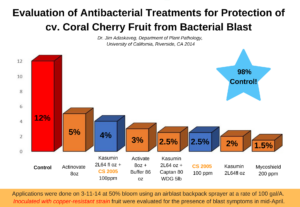Protect Your Cherry Orchards from Bacterial Blast with Magna-Bon CS 2005
Bacterial canker and blast can devastate cherry orchards, especially during cold, wet conditions in bloom. According to Dr. Jim Adaskaveg of UC Riverside, these diseases thrive under such conditions, causing significant damage to trees and yields.
Recognizing the Symptoms
Dr. Adaskaveg, as outlined in UC Pest Management Guidelines, describes the symptoms of bacterial blast as:
- Limb dieback with rough cankers and amber-colored gum
- Leaf spots and blast of young flowers and shoots
- A “sour sap” phase, where inner bark turns brown, fermented, and sour-smelling
- Bacterial invasion in bark occurring outside canker margins
- Trees frequently suckering near the ground, with cankers not extending below the soil
Proven Efficacy with Magna-Bon CS 2005
In the research trial Evaluation of Antibacterial Treatments for Protection of cv. Coral Cherry Fruit from Bacterial Blast, Dr. Adaskaveg tested multiple treatments, including Magna-Bon CS 2005. The coral cherries were inoculated with a copper-resistant strain of bacterial canker, yet Magna-Bon CS 2005 achieved an impressive 98% control of bacterial blast.
The study demonstrated that Magna-Bon CS 2005 is a highly effective solution for controlling bacterial canker, even against copper-resistant strains.
Recommended Application for Best Protection
To effectively suppress bacterial blast and canker, follow these label recommendations:
✅ First Application: Before fall rains
✅ Second Application: Late dormant stage
✅ Additional Application (if needed): Shortly after harvest in severe cases
Application Rates:
- Per Acre (per 100 gal. of water): 32 – 64 oz
- Copper PPM per 100 gal. of water: 200 – 250 PPM
- Optional: Agricultural spray oil may be added when conditions favor disease.
Additional Expert Insight
According to Jeff Alicandro, dormant copper fungicide applications—both in fall and early spring—are key to bacterial canker suppression. Split applications provide better control, especially for highly susceptible sweet cherry cultivars.
Don’t Let Bacterial Blast and Canker Destroy Your Orchards
Take action before it’s too late. Protect your cherries with Magna-Bon CS 2005 – an OMRI-listed copper sulphate pentahydrate in-solution formula with 98% control against bacterial blast.










